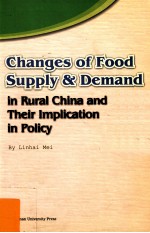

中国农村粮食供求的变化及其政策的意义PDF电子书下载
- 电子书积分:10 积分如何计算积分?
- 作 者:梅林海编著
- 出 版 社:广州:暨南大学出版社
- 出版年份:2003
- ISBN:7810792644
- 页数:239 页
PART ONE An Overview of the Study 3
1 Concept,Method,Implication 3
1.1 Concept,Method,Implication 3
1.1.1 The Essential Factors of the Study 3
1.1.2 The Principal Theories 3
1.2 The Organization of the Thesis 6
2 Background and Purpose of the Study 10
2.1 Background of the Study 10
2.2 Purpose of the Study 13
a The First Objective 13
b The Second Objective 15
c The Third Objective 16
References 18
PART TWO Rural Reforms and Their Effects on Chinese Food Supply and Demand 18
3 Review of Food Demand and Supply in China 23
3.1 Introduction 23
3.2 Previous Studies on Food Supply and Demand 25
3.3 Factors Affecting China's Demand for Grain 25
3.3.1 Findings from Estimated Elasticities of Food Demand 27
a Food Grain 28
b Animal Protein Food 29
3.3.2 Studies on Factors Affecting Food Consumption 32
a Population Effect 32
b Feeding Efficiency 33
c Seed Input 34
d Waste of Grain 35
e Dietary Habits 36
3.4 A Re-Estimate of the Food Consumption in China 36
3.5 A New projection for Food Demand 39
3.6 Summary 42
Notes and References 43
Appendix 1(表l~9) 51
4 Impact of the Policy Change on Grain Production 60
4.1 Introduction 60
4.2 Household Responsibility System(HRS) 61
4.2.1 The Introduction of HRS 61
4.2.2 The Role of HRS 62
4.3 Marketing Reform 63
4.3.1 The Course of Marketing Reform 64
4.3.2 The Effect of Marketing Reform 64
4.4 Price Reform 68
4.4.1 The Three Stages of Price Reform 68
4.4.2 Implication of Price Reform 71
4.4.3 The Necessity for Further Reforming 72
4.4.4 Suggestions for Future Price Reform 74
4.5 WTO Accession And China's Agriculture 77
4.5.1 The Most Recent Agricultural Marketing and Policy 77
a Production of Principal Agricultural Products 77
b Market Development of Principal Agricultural Products 79
c The Development of International Trade of Farm Products 80
d New Market Policy Development in Determining the Performance of Agriculture 82
4.5.2 The Review of Negotiations for China's Entry into WTO and Its Impacts 85
a Tariff Reductions 85
b Tariff Rate Quota System 86
c Other Trade Measures 86
d General Assessments of the Possible Impacts of China's Commitments 87
e Specific Products Analysis of the Possible Impacts 88
4.5.3 Policy Suggestions 89
a Capability Building Policies 90
b Structural Adjustment Policies 90
c Income and Employment Policies 91
4.6 Sununary 92
Notes and References 93
Appendix 2(文件选摘) 97
5 The Characteristics of Food Consumption Changes in Rural China 116
5.1 Introduction 116
5.2 Income Growth in Rural China 117
5.3 Changes of Living Expenditure 120
5.4 The Role of Price 124
5.5 Food Consumption Patterns 130
5.6 Regional Variations in Food Consumption 133
5.6.1 Classification of Chinese Food Consumption Regions 133
5.6.2 The Traits of Regional Variations 133
5.7 Comparison of Urban and Rural Food Consumption Patterns 136
5.7.1 Food Consumption in the Urban Areas 138
a The Features of Food Consumption 138
b The changes of Food Consumption 139
c Food Consumption by Income Groups 141
5.8 Comparison ofUrban and Rural Food Consumption 143
5.9 Summary 147
Notes and References 150
Appendix 3(表10~14) 155
PART THREE Analyses and Discussions——An Engel's Theory Approach 155
6 Analyses of Influential Factors on Engel's Coefficient in Rural China 163
6.1 Introduction 164
6.2 Various Factors Affecting Engel's Coefficient 165
6.2.1 Engel's Law 165
6.2.2 Features of Income Changes 168
6.2.3 Changes and Features of Food Consumption 169
6.2.4 Features of Living Expenditure 171
6.2.5 Changes in Policy 175
6.3 A Multiple Regression Model 177
6.3.1 Data Sources 177
6.3.2 The Methodology 177
6.3.3 Estimation 179
6.4 Summary 182
Notes and References 183
7 The Impacts of Income Difference on Food Consumption in Chinese Rural Households 187
7.1 Introduction 188
7.1.1 Data Sources 191
7.2 Characteristics of Food Consumption by Income Groups 192
7.2.1 Delimitation of Income Groups 192
7.2.2 Characteristics of Food Consumption Patterns 193
7.3 Estimation of Demand Elasticities 195
7.3.1 Functional Form 195
7.3.2 Estimates 196
a Income and Price Elasticities for Grain 199
b Income and Price Elasticities for Meat 200
c Income and Price Elasticities for Poultry,Eggs,Aquatic Products and Liquor 200
7.4 Engel Curves for Rural Households 201
7.5 Summary 205
Notes and References 206
8 Findings,limitations and Policy Implications 209
8.1 Summaries of Evidence Analyses 209
8.2 Summaries of Engel's Theory Approach 214
Bibliography 217
论文要旨 231
后记 238
- 《思维的囚徒 活出生命的意义7原则》赵晓瑞译;(美)亚历克斯·佩塔克斯 2019
- 《气候变化与环境治理研究》生态环境部环境与经济政策研究中心编著 2019
- 《变化环境下的生态水文效应模拟》李琼芳著 2019
- 《中国农村经营管理统计年报(2015年)》农业部农村经济体制与经营管理司,农业部农村合作经济经营管理总站编 2016
- 《国际格局变化与中国 建构主义理论的新视角》王庆新著 2019
- 《农村生活污水处理工艺与技术应用》李灵娜著 2019
- 《农村废弃物利用与处置技术》刘作云编著 2019
- 《1975年的粮食》谢根林著 2014
- 《全面小康目标下甘肃农村反贫困研究》杨智 2017
- 《农业农村面源污染防控技术》张庆忠,梅旭荣,朱昌雄主编 2019
- 《市政工程基础》杨岚编著 2009
- 《家畜百宝 猪、牛、羊、鸡的综合利用》山西省商业厅组织技术处编著 1959
- 《《道德经》200句》崇贤书院编著 2018
- 《高级英语阅读与听说教程》刘秀梅编著 2019
- 《计算机网络与通信基础》谢雨飞,田启川编著 2019
- 《看图自学吉他弹唱教程》陈飞编著 2019
- 《法语词汇认知联想记忆法》刘莲编著 2020
- 《培智学校义务教育实验教科书教师教学用书 生活适应 二年级 上》人民教育出版社,课程教材研究所,特殊教育课程教材研究中心编著 2019
- 《国家社科基金项目申报规范 技巧与案例 第3版 2020》文传浩,夏宇编著 2019
- 《流体力学》张扬军,彭杰,诸葛伟林编著 2019
